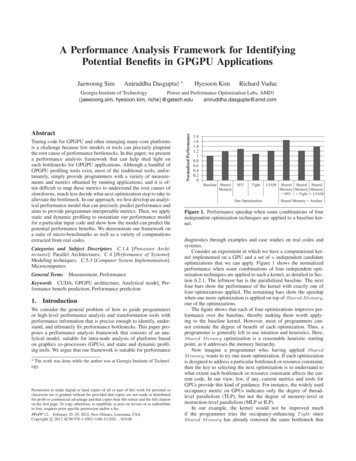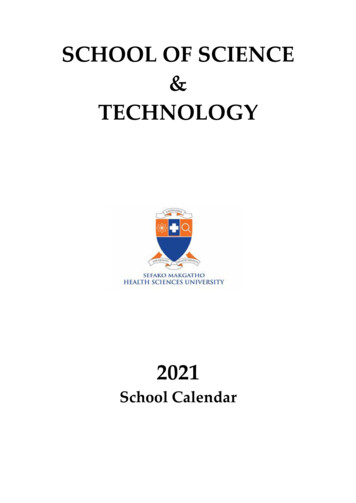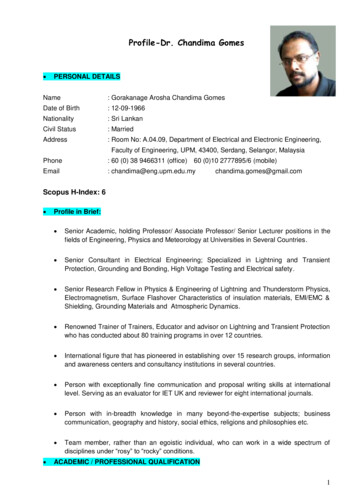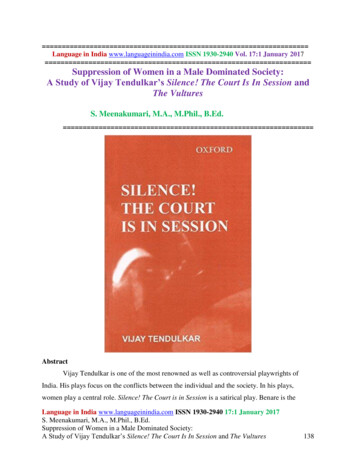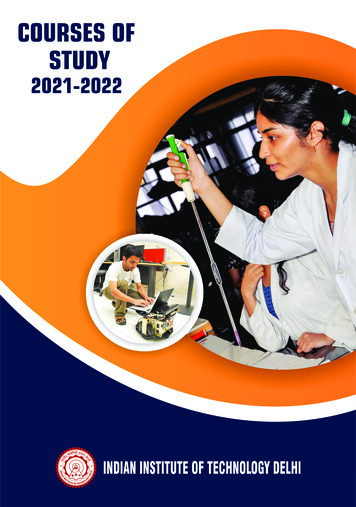
Transcription
BYSHASHIBHUSANDASGUPTA,M.A.,PH.D.,Lecturer, Calcutta Univwsity
Printed in IndiaPUBLISREDBY ALCUTTAUNIVERSITY48, HAZRAROAD,BALLYOUNOE,C A L C U ANDAPRINTEDAT THE MODERNARTPRESS,112, DUROAPITURILANE,CALCUTTA.
ToThe Revered and BelovedMemory ofPROFESSORBENIMADHBARUAAB
-XXIXI1PRELIMINARY(i) Mission of the Tantras in General and the Buddhist,.Tantras in Particular.(ii) The Salient Featureo of Mahayana as contrastedwith H i n a y h a(A) The Final Goal.(B) The Three Schools-Sr vakay na, PratyckaBuddhayBna and Bodhisattvayilna.(C) -The PBramitBs(D) The Docetic Conception of the Three Ki yas.(E) Predominance of Philosophical Thoughts.(iii) Philosophical systems(A) MBdhyamika Philosophy of Nggsrjuna(B) The TathatB-vHda of Advaghosa(C) Vijfilna-vgda or YogHcara(D) Affinity with Vedanta.UNSYSTEMATISED PHILOSOPHICAL FRAGMENTSFOUND I N THE BUDDHIST TANTRAS.a41-59CHAPTER111SCHOOLS OF TANTRIC BUDDHISM(i) The Evolution of Mantrayana(ii) Vajrayana-themost common name.(A) KBlacakrayBna, Nathism, etc.(B) General Characteristics of VajrayHna.60-7070-8572-7878-85
CONTENTSTHE THEOLOGICAL POSITION OF TIIETANTRIC BUDDHISTS(i) Vajra and Vajrasattva,.Pages.?.8 6 98.98-125(ii) Bodhicitta.98-100(A) General Conception of Bodhicitta(B) Sfinyat rand KarunB as Prajfia and UpAya . 100-105(C) Cosmological and Ontological Aspects of PrajABand Upayn.(D) Prajiia and Upaya as Male and Female.(E) Prajfiii and UpBya as Lalanli-Rasana, Left.and Right, Vowel and Consontrnts, etc.(iii) Advaya (Non-duality) and Yuganaddha (Principle.of Union).(iv) Raga (Affection) and Maharaga (Great Affection)(v) Samarasa.(vi) Mahasukha (Supreme Bliss) as the Final Goal:Nirvana and Mahasukha(A) Nirvana ns Positive State of Bliss(B) Nirvana as Mahasukha in the Buddhist Tantras(C) The Cosn ologicaland Ontological Significanceof Mahasukha(D) Mahlsukha in Relation to the Esoteric Practice(E) The Transformed Idea of nodhicitta in Relationto the Esoteric Yogic Practice.T H E ELEMENT OF ESOTERIC YOGA(i) Body-the Medium for Realising the Truth(A) The Theory of the Plexus.(B) The Nerve System.(ii) Selection of the Preceptor.160-196.161-174161-169169-174.and the Four.174-178(iii) The Production of Bodhicitta and its Regulation178-19.0(iv) The Four MudrHs, Four Momentskinds of Bliss190-196.THE ARGUMENT O F THE TANTRIC BUDDHISTSI N DEFENCE O F THEIR YOGA197-217Bibliography219-224Word Index.,.225-285
PREFACEThe present work embodies substantially the thesissubmitted by the author, and approved, for the Premchand Roychand Studentship of the University ofCalcutta in 1987. Due to the abnormal conditionsprevailing in the Country during and after the WorldWar 11, the author could not arrange to have his workpublished earlier, i t is being published after a lapse oftwelve years-an Indian Yuga. Though very late, theauthor feels i t a duty to bring before the reading publicthe fruits of his labour in the hope that they may beof some use and interest to those who find pleasure inmaking an academic study of a religious subject.Whether Vedic or Non-Vedic in origin, Tantricism,both Brahmanical and Buddhistic, represents a specialaspect of the religious and cultural life of India. Athorough study of Tiintricism is, therefore, indispensable for a close acquaintance with the special qualityof the Indian mind. For a long time it was customaryto hold that Tantricism is an off-shoot of IIinduism, orthat i t constitutes only a particular phase of HinduSiidhanii ; but researches in later Buddhism have nowbrought home that, so far as the extant literature isconcerned, the stock of Tiintric literature is richer andmore varied in the domain of Buddhism than i11 thatof Hinduism. Much more, i t is hoped, may berecovered or reconstructed from the Tibetan andChinese sources. Thanks to the scholarly endeavourof the Oriental Institute, Baroda, which has publisheda number of important Buddhist Tiintric texts andmade them available to the scholar and the generalreader.TBntricism, whether Hindu or Buddhistic, (andwe shall presently see that they are fundamentally thesame) has been the target of all sorts of criticism,
charitable and uncharitable, from scholars, bothOriental and Occidental. It has often been styled asa school of religious mysticism, where the word mysticism is taken, more often than not, as a loose synonymfor puzzling obscurity. The present author has, however, tried to keep his mind open as far as practicablethroughout the whole study. His interest has mainlybeen academic and cultural. He has studied a considerable number of texts, both published and unpublished, gathered information, analysed and classified them and has then tried to give a correct expositionon textual basis, avoiding personal observations andjudgment as far as possible. There are many thingsin the practices of the Tiintrikas which are undoubtedlyunconventional ; the author has tried to exhibit themwithout offering any apology or advocacy. If errorshave crept in, in the form of mis-statement or misinterpretation, they are due mainly to the fact thatancient religious literature, embodying complicatedpractices and subtle realisation, may not be decipheredproperly by " our modern spectacled eyes."The inspiration of the author came .from anothersource. It is known to all students of the ModernIndian Languages that the literature of the earlyperiod-particularly in Bengali--comprises a numberof songs and Dohiis, dealing with the tenets of theTiintric Buddhists. To understand and appreciatethe meaning of these songs and Dohiis the Tlntricbackground must be clearly understood. The presentstudy was an attempt towards that direction. Thisstudy brought to the notice of the author many newand interesting facts which led him to pursue his studyfurther and the findings of further researches in thisdirection have been incorporated in his book, ObscureReligious Cults as Background of Bengali Literature(published in 1946 by the University of Calcutta).As the number of published texts on Tiintric
PREFACEix.-Buddhism is very scanty, the author had to collect hismaterials mainly from unpublished manuscripts. Asthere is no possibility of many of these texts beingpublished in the near future, the author has deemedit proper to quote copiously from these manuscripts toillustrate his points and to substantiate his generalisations. This, the author hopes, will give the reader a,better opportunity for making his own judgment andalso for testing the validity of the statements madeand conclusioi sarrived at. Because of the obscurenature of the topics tliscussed the author had to reintroduce sornc of then1 in different contexts, whichrnittle some alnoun t of repetition unavoidable.A few words should be said about the manuscripts, nosL of which are preserved in the Royal AsiaticSociety of Bengal, some in the Central Library, Rorodu,some in the library of the Cambriclge University, somein the Bibliotheqlie Nationsle, Paris. Except the nanuscriptspreserveci in the Royal Asiatic Society ofBengal, all the other mailuscripts were available to thepresent writer in rotograph through the courtesy of1)r. S. N. Dasgupta, M.4., P1i.D. (Cal. & C,antab.), D. Lit.(Rome), the then Principal of the Sanskrit College,Calcutta. Apart froin the fact that the manuscripts,scribed on palm-leaves, or indigenous hand-aladepaper in Newari (old Nepalese script), the texts are fullof corruptions. Further, the texts were not composedin strictly correct and elegant Sanskrit. The metre isoften defective ; words arc soil etimesused withoutproper suffix ; wrong forms are used in analogy ; sandhiis not treated as essential ; pseudo-Sanskritic wortlshave crept in due probably to the influence of theVernaculars. Because of all these the author has not.thought it wise to tamper with the reading of themanuscripts in the form of corrections. Correctionshave been made or suggested only in cases where themistake or the corruption has bee11 palpable. As for'
XPREFACEtranscription, the author has experienced some typographical difficulty and a few words had to be leftunmarked or without proper marking.The author acknowledges his indebtedness to hispredecessors, who have worked in the field. Thenature and extent of such indebtedness have alwaysbeen indicated in foot-notes. Reference of manuscriptsinclude the folio number and the serial number in thelibraries or institutions where they are preserved.
ACKNOWLEDGMENTSThe author takes this opportunity of recording hisdeep sense of gratitude to Professor S. N. Dasgupta,the great Indian Philosopher, for the help, advice andencouragement the author received from him. Professor Dasgupta drew the attention of the writer to thesubject of his study and procured for him manymanuscripts from abroad. Some portions of this workwere published in the journal Indian Culture in theform of separate articles ; for this the board of editorsdeserves thanks from the author. The author receivedhelp from Father Pierre Fallon, M.A., in preparing thepress-copy of the manuscript. The author acknowledges his indebtedness to Professor K. N. Mitra, M.A.,under whose affectionate care the research on thesubject was carried on. The author thanks theRegistrar (Offg.) of the Calcutta University, Sri Satishchandra Ghosh, M.A. and the Superintendent (Offg.) ofPress, Sri Sibendranath Kanjilal, B.Sc., DIP., PRINT.(Manchester) for the interest they took in the printingand publication of the book.
ABBREVIATIONS.Bibliotheque Nationale, ParisCentral Library, BarodaGaekwad's Oriental SeriesJournal of the Royal Asiatic SocietyRoyal Asiatic Society of Bengal
CHAPTER IPRELIMINARY(i) Mission Of The Tantras In General And TheBuddhist Tantras In ParticularThe primary concern of the Buddhist Tantras is notto establish a definite system of metaphysical thought.Just as the Hindu Tantras, taking for granted thefundamental tenets of the DarSanas, apply them to apractical effort of realisation, so the Buddhist Tantras,on the basis of the Mahiiygna principles, dictate practical methods for the realisation of the supreme goal.%Ideas, current in other religious circles, are also incorporated. These Tantras are primarily concerned withthe Siidhanii or the religious endeavour, but not withany system of abstract philosophy. The philosophicaliportions introduced here and there can neither successfully explain the various practices and rituaIs, nor arethey always relevant to the topics with which the Tantras are generally concerned. The main object of theTantra literature is to indicate and explain the practicafmethod for realising the truth, and so, the abstractmetaphysical speculations could never find any prominence in it. The different metaphysical systems dealwith the nature of the reality and the philosophicmethod for its realisation ; whereas the Tantras laystress on the esoteric methods for realising that reality.n short, the Tantra, whether Hindu or Buddhistic, haso be regarded as an independent religious literature,which utilised relevant philosophical doctrines, butwhose origin may not be traced to any system or systems of philosophy ; it consists essentially of religiousmethods and practices which are current in India froma very old time. The subject-matter of the Tantras4may include esoteric yoga, hymns, rites, rituals, doctrines and even law, medicine, magic and so forth.4
2T N T R BUDDHISMCEtmologically the word Tantra may be taken tomean any kind of elaboration (if derived from the roottan, to spread), or to mean knowledge (if derived fromthe root tantri).' Taking the first derivation, Tantramay be explained as that which spreads knowledge(tanyate, vistiir ate jfidnamanena ititantram).P h e r e is thus a wider connotation of the word Tantlato mean any 'expanded' literature which deals elaborately with any department of study either in atheoretical or in a practical manner. Thus some systems of philosophy have often been referred to asTantras, e.g., Ngdga-tantrep, Siimkhga-tantrehu, orCikitsbtantresu, and so on. Byt it has also a limitedconnotation inasmuch as the word Tnntra means anesoteric literature of a religious and practical nature.It is difficult to say how the use of the word Tantrain this limited sense became so important that in common parlance the word seems to have acquired almostentirely %his specialised sense. The treatment hereinfollowed is limited to this specialised Tantra literatureas a practical esoteric science.Because of this practical nature of the Tantras,they have never been the subject for pure academicdiscusqion. They have always been transmitted fromthe preceptor to the disciple in the most secret mannerand it has always been held an unpardonable crime onthe part of a Siidhaka to let the uninitiated into thesecret of their Siidhanii.A critical study of the nature of Tiintric Buddhismwill reveal that there is no organic relation betweenTBntricism and Buddhism of any form. It is not afact that. Buddhism, in the course of evolution in anybof its aspects, developed within its arena the compositepractices known as Tiintricism ; on the other hand,Buddhism, in the later phases of Mahiiyiina, seems tohave adopted these practices, which were a growth ofSee an article General Introduction to T a n t aPhilosophy byDr. S. N. Dasgupta in his PhiZosophicJ Essays (Calcutta University).
MISSION OF THE TANTR,AS8the soil and as such a common heritage both of theHindus and the Buddhists, I n short, Buddhism did notevolve them out of its own materials. We have saidthat as a religious science TBntricism has its independent history ;its association with Buddhism may historically be explained with reference to the spirit ofcatholicity which characterises Mahiiyiina Buddhismas a whole. It will be more correct to say that theTiintric theological speculations that are found in theBuddhist Tantras represent the gradual transformationof later MahByiinic ideas, effected through the association of the various Tiintric practices, than to say thatthe practices are there because of the theological speculations.There seems to be no essential difference betweenTgntricism within the province of Hinduism and thatwithin the province of Buddhism. Apart from themultifarious accessories, to judge by the essentials,TBntricism, both Hindu and Buddhist, lays stress upona theological principle of duality in non-duality. Boththe schools hold that the ultimate non-dual realitypossesses two aspects in its fundamental nature,-thenegative (nivytti) and the positive (pravytti),the staticand the dynamic,-and these two aspects of the realityare represented in Hinduism by Siva and Sakti and inBuddhism by Prajiiii and Upiiya (or Siinyatii andkarunii). It has again been held in the Hindu Tantrasthat the metaphysical principles of Siva-Bakti aremanifested in this material world in the form of themale and the female ;Tiintric Buddhism also holds thatthe principles of P r j f i i i and Upiiya are objectified inthe female and the male. The ultimate goal of boththe schools is the perfect state of union-union betweenthe two aspects of the reality and the realisation of,the non-dual nature of the self and the not-self. Theprinciple of Tiintricism being fundamentally the sameeyerywhere, the superficial differences, whatever thesemay be, supply only different tone and colour. While
4 .T NTRIC BUDDHISM,the tone and colour of the Hindu Tantras are suppliedbp the philosophical and religious ideas and practices. of the Hindus, those of the Buddhist Tantras are supplied by the ideas and practices of the Buddhists.If we analyse the Buddhist Tantras we shall findthree elements in them, vix., (1) the unsystematised netaphysical fragments taken from the differentschoois of Buddhistic thought, particularly from Mahiiylna Buddhism and also from cognate Hindu thought ;(2) a Tlntric theology, which, though substantially thesame as found in the Hindu Tantras, utilised relevantlater Mahlylnic ideas ; (3) practices. Apart from thefundamental theological position, we find in the HinduTantras tlie ideas of Vediinta, Yoga, SBmkhya, Nyiiyavaigegika, the PurQas and even of the medical sciencesand the law books-all scattered here and there ; soalso in the Buddhist Tantras we find fragments of metaphysical thought, which are all taken from the leadingschools of Mahiiyiina Buddhism as influenced by Upanieadic monism. Ideas are often put side by sideindiscriminately without knowing their import andimportance, and as a result we find Sfinya-viida, Vijiilna-vlda and Vediinta all confusedly jumbled together.The leading tenets of early Buddhism also lie scatteredhere and there side by side with the Mahayiinic andBrahminic ideas and the other Indian systems likeSBmkhya and Yoga also have been frequently introduced in a rather distorted form.For all practical purposes, let us first of all try totake a general survey of the philosophical and theological background of the Buddhist Tantras and thenthe three elements, spoken above, will be taken intoconsideration in order.(ii) The Salient Features Of Mahlipiina AsContrasted With HinaganaBuddhism has been historically as well as philosophically divided into two great schools, vix., H i n a y h at
and MahiiyBna. By Hinayana is generally meant thePHli Buddhism of the earlier period and i t is also popularly known as the Southern Buddhism and its followers are found in the Southern countries like Ceylon,Burma, Siam, Java, Sumatra, etc. ; by MahiiyiinaBuddhism on the other hand is meant the later SanskritBuddhism current in the Northern countries like China,Japan, Tibet, Nepal, etc. ' The later Buddhistswould style their school as the MahGyiina or the 'greatvehicle ' in contrast to the narrow and orthodox schoolof the Buddhists of earlier times, whom they woulddesignate as belonging to the Hinaygna or the 'littlevehicle '. I n the Mahiigiina-sutriilankiira of Asanga theHinayiina has been condemned as very narrow becausec;f its five points of difference with the Mahiiyiina.These are, firstly, the narrow aim of self-liberation and,secondly, the narrow teachings to realise that aim,thirdly, the narrow method applied for this realisation,fourthly, insufficiency of equipment and, fifthly, theshortness of time within which final liberation isguaranteed. Y n fact, the Mahgyiina school is alwayscharacterised by a broadness of outlook, and deepsympathy for the suffering beings. But it may beobserved in this connection that as on the one handthis freedom of thought, broadness of outlook and thespirit of liberalism saved Buddhism from the walls ofnarrow scholastic dogmati'sm and raised it from theselfish hankering after personal liberation to the sublimity of a religion for the suffering humanity, on theother hand, i t contained also germs of indiscipline andrevelry of wild thoughts which were responsible for theincorporation of all sorts of practices in Buddhism.The word Mahiiyiina, as we find it mentioned in' Many Mahiiyiina scholars of recent times, however, think thatthe Mahayiina view is as old as the Hinaylna.iis'ayasyo' padedasya prayogasya virodhatah lupastambhasya kiilasya yat hinam hinarn eva tat 11Makyiina-sBtralankd a. Ch. I , Verse 10.*LBviys Edition.-
the Awakening of faith in Mahtiyiiw (Mahiigiina-graddho-tpiida-siitra) of ARvaghoga, ' meant the highestprinciple or reality, or the knowledge which is the primordial source of the universe as a whole ; and all theobjects, animate and inanimate, are nothing but themanifestations of that one unchanging and immutableprinciple, and only through it final salvation of allhistorically Mahiiylna refers tobeings is possible. "utthe school of Buddhism which is styled by its adherentsto be the great way to salvation because of the universality and generosity of its tenets. It is held traditionally that after the death of Buddha, there arose agreat controversy among his disciples as to the correctinterpretation of the sayings of the Master and alsoabout the rules of discipline indispensable for a monk.Great councils were convened to settle these controversies. It is said that in the second council held inVesiili the controversy finally ended i n a split up amongthe Buddhists and the dissenters convened anothergreat assembly (Mahiisangha) to have a, separate schoolof their own and they were known as the Mahiisiinghikas. I n this way, as time was passing on, the controversy between these radicalists and the orthodox elders(thera) began to be gradually accelerated and it finallyresulted in the growth of the two separate schools ; thecanonical tenets of the elders being styled as Hinayiina, and that of the latter as Mahiiylna. Withoutentering into the details of the historical developmentof the Mahlyiina doctrine, it will be sufficient for ourpurpose here to draw an outline of the leading tenetsof the Mahiiyiina school and its points of controversywith Hinaylna.' Modern scholars are, however, loath to accept Advaghoga as theauthor of the work Mahizyiinacdraddho-tpada-sfitra. There is again agreat deal of controversy over the time of Advaghoga; but TeitaroSauki says,-" S a d e it ta say that he lived s t the time extendingfrom the latter half of the ftrst 'century before Christ to about 50 or80 A.D."-Awakening of Faith in Makiyiinp, -p.17.aIlia., pp. 68-54.
MAHbyhNA AS CONTRASTED WITH H N A Y N A7(A) THEFINALGOALAs for the final goal the Mahiiyiinists believe thatevery man-nay, every being of the world is a potentialBuddha ; he has within him all the possibilities ofbecoming a Samgak-sambuddha, i.e., the perfectly en,lightened one. Consequently the idea of Arhathood ofthe i n a i i n i s wast s replaced by the idea of Bodhisattvahood of the Mahiiyiinists. The general aim of theHinayiinists was to attain Arhathood and thus throughnirvtina or absolute extinction to be liberated from thecycle of birth and death. But this final extinctionthrough nirviina is not the ultimate goal of the Mahiiy8nists ; their aim is to become a Bodhisattva. Herecomes in the question of universal compassion (mahtikarunii) which is one of the cardinal principles ofMahSiyiina. The Bodhisattva never accepts nirvtinathough by meritorious and righteous deeds he becomesentitled to it. He deliberately postpones his own salvation until the whole world of suffering beings besaved. His life is pledded for the salvation of theworld, he never cares for his own. Even after beingentitled to final liberation the Rodhisattva works forthe uplift of the whole world and of his own accordhe is ready to wait for time eternal until every suffering creature of the world attains perfect knowledge andbecomes a Buddha Himself. Ordinary people of littlemerit would always take refuge in the all-compassion;ate Bodhisattva. To pray for the compassion of theBodhisattva was deemed as one of the best ways ofbeing relieved of all suffering.' The grand example ofAvalokiteivara Bodhisattva's renunciation of Nirvinain favour of suffering humanity, described in the d i a d h - v i iwillh a , inspire a feeling of sublime rever-' Cf. samanviiharantumiim buddMh krpd-karund-cetasah Iye ca dada-didi loke tisthanti dvipado-ttamSih 11yac ca me piitakam karma krtam pilrvarit sudiiruna n Itat survnh deiuyisy6mi sthito duku-bala-grutnh ( 1 etc.-Si&sii-san ziccaya?t. Bendall's Edition, pp. 160-61.
8T R I CBUDDHISMence for all time to come.' The whole of M lh&yBnaliteriture breathes this spirit of universal compassion,and all the metaphysical and religious discourses areintroduced avowedly with the intention of renderinghelp to the afflicted in getting rid of their afflictions.I n the text Bodhi-caryii-vatlira we find the Bodhisattva praying for the distressed :-"Withclaspedhands do I pray to all the perfectly enlightened onesin all the quarters,-light the lamp of religion for allthat are fallen in sorrow for attachment. With clasping hands do I beseech all the self-controlled wise, whoare bent on attaining the final extinction, to wait forinnumerable ages,-let not this world be dark (withoutthem). Let by all the good I have thus attainedthrough these (righteous) performances all the sorrowsAll myof all the beings be completely pacified.existence-all my happiness-all my good in the threeworlds unconditionally do I renounce for the fulfilmentof the desire of all beings. My mind is bent on Nirviina,and everything has to be renounced for the sake ofNirviina, but if I am to sacrifice everything let all be. Let them sport with my bodygiven to all things.-let them laugh-and amuse ; when the body is dedicated to them why should I take any more thoughtof i t ? Let them do any work they please to do withthis body of mine ; my only prayer is,--let not any evilcome to them with reference to me. Let all that will." I t is said that when Avalokitedvara Bodhisattva, after obtaining Nirvhna, was about to merge himself in the eternal gfinya fromthe summit of the Sumeru mountain he heard an uproar from a veryremote quarter and became remorseful. He sat there forthwith inintense meditation, and immediately realised that the uproar wasnothing but the wailings of the people at the disappearance ofAvalokite vara, the all-compassionate Bodhisattva. In their utterhelplessness at the prospect of losing the support of. Avalokitedvara,who was their only saviour from their worldly miseries and sufferings,they rent the sky with their bitter wailings. Avalokitehara wasdeeply moved and when he came to know about this he resolved withinhimself not to accept his well-merited emancipation so long as even asingle individual on earth remained unemancipated," An Introduction to Buddhist Esoteriem-by Dr. B. Bhattacharya, p. 29.
M A H Y NASA CONTRASTED' WITHHTNAYTNA 9speak ill of me-that will do harm to me, that willlaugh a t me-be' entitled to attain perfect knowledge. "'This feature of universal compassion was one of themost important factors that popularised Buddhism verymuch in the lands far and wide and gave the religiona deep humanitarian tone. It is by this emphasis oncompassion and also on devotion that MahiiyiinaBuddhism could very easily attract the sympathy andattention of millions of people and could also harmoniseitself with the current religious trend of India.'In connection with this question of universal colnpassion we may mention the general scheme of classifying the Buddhists into the Sriivakas (i.e., the hearers),the Pratyeka-Buddhas (i,e., the individualistic Buddhas)and the Bodhisattvas (i.e., those whose very essenceis knowledge). The Sriivakas are those who alwayslisten to the preachings of the learned and tryto follow them in their life. They try to understandthe four noble truths (iirga-satya) and to attain parinirvana through a right comprehension of them. Theyhave mastery over the ten good actions, possess mentalpower (citta), but they have not the universal compassion (n ahd-karuyi)which might inspire them forthe well-being of the suffering world. They are alwaysbusy with themselves and so are regarded as the lowest in the rank. The middle place is assigned to thePratyeka-Buddhas. They are bent on self-control andgenerally lead a solitary retired life. They do not require the instructions of any teacher to guide them atevery step. They can comprehend the cause and conditions (hetu-pratyaya) of things, and, through a rightcomprehension of the nature of causality attain salvation for themselves. They too do not possess karunii' Ch. 111, Verses 4-6,0 , P. 1-210-11, 18-15.
and so are ranked below the Bodhisattvas. The Bodhissttvas are those who are more purified, have fullcontrol over their passions, have the right knowledgeof all the expedients, have great resolution ; perfectenlightenment is their only support. Through theirupward march through the ten stages (daia-bhiimi)and through the constant practice of the piiramitiis(the best virtues) they attain Buddhahood ; and theyattain Buddhahood never for their own sake, but for'saving the whole world. I n them mahii-karunti hasgot the fullest scope and so they are the best of men.(C) THEPXRAMITXSI n this connection we should also have a cursoryglance at the MahByBnic conception of the six piiramitiEs or the best moral virtues and the conception of theBodhicitta or the mind as enlightenment, and the production of the Bodhicitta (bodhi-citto-tpiida). Thepiiramitiis are the moral virtues through the practiceof which the aspirer crosses the sea of existence andreaches the other shore.' These are charity (diina),good conduct (&la), forbearance (ksiinti), spiritualenergy (virya), meditation (dhglina) and knowledge(prajfiii). After these virtues are acquired and themoral ground is prepared the aspirer is to produce astrong resolution in his heart for the realisation of hiscitta as perfect enlightenment. This is what is calledthe production of the Bodhicitta. The Bodhicitta proper involves within it two elements, viz., perfect' enlightenment of the nature of void (diinyatii) anduniversal compassion for the beings (karunii) ; theseSQnBatii and karunli combined together give rise toBodhicitta, After its production, the Bodhicitta proceeds on in an upward march through ten differentstages which are called the bodhisattva-bhiimis (i.e., thestages of the Bodhisattva). The first of these is the-' PHramita literally means that which takes one to the other shore,'
M A H NA 8A CONTRASTED WITH HTNAYXNA11stage of Pramuditii or the stage of delight or joy. Herethe Bodhisattva rises from the cold, self-sufficing andnihilistic conception of nirviina to a higher spiritualcontemplation. The second is styled as the VimaEii orthe stage free from all defile
Tantra literature is to indicate and explain the practicaf method for realising the truth, and so, the abstract metaphysical speculations could never find any pro- minence in it. The different metaphysical systems deal with the nature of the reality and the philosophic method for its realisation ; whereas the Tantras lay

